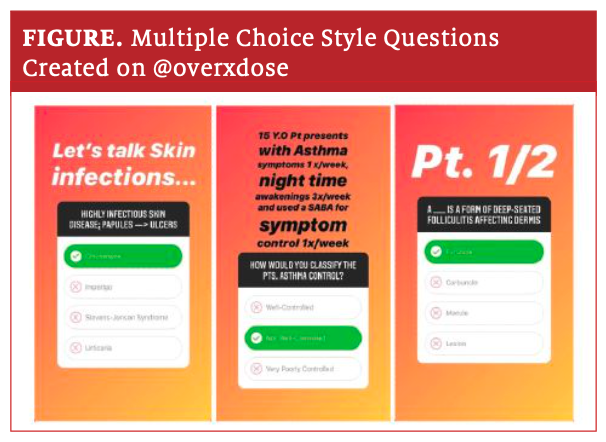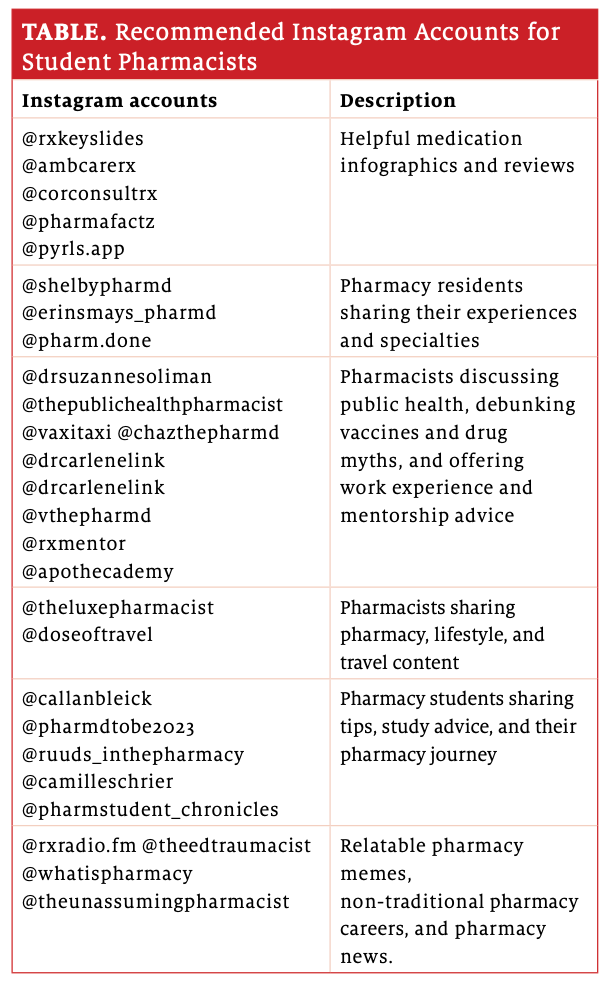Article
Lessons Learned on Instagram
Author(s):
In 2019, an article in the Journal of the American College of Clinical Pharmacy encouraged pharmacists to engage professionally on social media, despite their having mostly avoided it for such purposes.
In 2019, an article in the Journal of the American College of Clinical Pharmacy encouraged pharmacists to engage professionally on social media, despite their having mostly avoided it for such purposes.1 The article piqued my interest because it appeared a year after I created my pharmacy podcast, OVERxDOSE (pronounced “overdose”), and just after I had launched a corresponding Instagram account (@overxdose).2
Today, most pharmacy students still use LinkedIn, Facebook, and YouTube for professional development and networking.3 However, there are many benefits—as well as risks—they should take into account when considering Instagram for career purposes.
The Good
1. Networking
One of the main benefits Instagram offers is more networking opportunities. Thanks to my account, I was able to connect with pharmacists around the country during the COVID-19 pandemic without ever meeting them in person at a conference or other event.
When I first ventured into the platform, I followed popular accounts like @rx.radio and @corconsultrx. By messaging the owners directly and asking for podcasting advice, I formed strong mentorship connections, and their guidance increased my social media success.
In addition, creating my own content and interacting frequently with others meant that Instagram’s search algorithm began to do the networking for me. As more accounts emerge, the platform continues to suggest new accounts for me to follow, so I can effortlessly expand my professional network.
2. Supplementing Classroom Learning
A meta-analysis conducted in 2015 found that Facebook was the only social media site being used as an educational tool in pharmacy.4 However, by 2021 it was common for other health care professionals to use Instagram to augment coursework, with quiz-style practice questions being the most popular content among followers.5,6
I noticed a similar trend when I published multiple-choice questions on my account (see Figure) to improve me and my classmates’ understanding of the material and prepare us for the exam.

3. Staying Up-to-Date on Technology
With online news consumption in the United States at an all-time high, more people are favoring platforms they can access on mobile devices over those on desktop computers. While scrolling through the news on their phones, people are more likely to switch to social media: they spend approximately 89% of their time on the device on social media, which makes it the quickest way to reach a targeted audience.7-9
By following accounts on Instagram, I learned about emerging technology and innovations that were revolutionizing the practice of pharmacy, like telehealth advances, the digitization of medication, the development of the automatic pill dispenser, and the latest in drug information.
4. Pursuing Creativity and Professional Identity
Social media also gives professionals an outlet for creative expression and for constructing an identity.10 Pharmacy students are expected to develop their professional selves as they progress through school and beyond. Instagram, which allows me to pursue my interest in storytelling, humor, and pharmacy all at once, has been my creative outlet. Through it, I can not only connect with others who share my passions, but I can also be an example of professional development for future pharmacists still working to find their own voice.
The Bad
1. Unprofessionalism
Unprofessional postings have had many negative consequences, from a warning to an expulsion from school and even a termination of employment.11 Studies have shown that medical students tend to post more unprofessional content and watch unprofessional content from peers more frequently than do faculty members.12,13
My first posts were pharmacy memes that some peers considered unprofessional. But by being open to constructive criticism from fellow students and the dean’s office, I quickly learned from my mistakes and adapted my posts to reflect the image and message I wanted to convey. A big risk of social media is publicity, but that is also its great strength.
Student pharmacists should be aware of the risks and balance them by taking the opportunity Instagram offers to be a voice for the profession and portray themselves as they want employers and patients to view them. In my opinion, the answer is not to be silent but to be purposeful on social media.
2. Distraction
It has been observed that the academic performance of pharmacy students correlates with how well they manage their time, and students have reported that their phones can be a distraction that is detrimental to their academic performance.12,13 Often, a quick break from studying to create content or scroll through my feed can turn into hours away from the books, making me less prepared for exams. Pharmacy students must find a balance, but this is true for all creative outlets.
3. Depressive Symptoms
Following strangers on social media can also lead to comparisons that can negatively impact the follower’s well-being.14 Research has shown that an increased use of Instagram is associated with more depressive symptoms. By following successful pharmacists, I myself have found that my well-being suffers when I compare their considerable accomplishments to my own. As I got to know other pharmacists better and they no longer felt like strangers, I noticed that my mental health improved.
Instagram Pearls
1. Follow Others for Ideas
Pharmacy students who want to create an Instagram account don’t have to reinvent the wheel. Viewing those featured on popular reposters like @pharmacistsofig, @talktoyourpharmacist, @pharmacisthub, and @pharmacistsincharge is a great starting point (see Table).

2. Pause Before Posting
Before publishing, students should read their school’s social media and professionalism policies and consider how their content might be viewed by an employer. If there is even a slight chance that the content violates a policy or could be viewed as unprofessional, it is best not to post it. On social media, nothing is truly anonymous, and people remain accountable for their posts.
3. Use Templates
Using free software like Canva, students can create or choose templates and schedule their posts. Consistently employing the same template and scheduling posts can save time and make for a more professional account.
As new social media platforms are created and more research is conducted on the subject, I hope pharmacy schools, pharmacists, and pharmacy students begin to view Instagram as a valuable tool that expands opportunities within the pharmacy profession.
David Dent is a PharmD Candidate 2022 at Virginia Commonwealth University.
References
- Kukreja P, Sheehan AH, Riggins J. Use of social media by pharmacy preceptors. Am J Pharm Educ. 2011;75(9):176. doi:10.5688/ajpe759176
- Dixon DL, Reed BN. To tweet or not to tweet? A primer on social media for pharmacists. J Am Coll Clin Pharm. 2019;2(5):554-562. doi:10.1002/jac5.1120
- Jeminiwa R, Shamsuddin F, Clauson KA, et al. Pharmacy students’ personal and professional use of social media. Curr Pharm Teach Learn. 2021;13(6):599-607. doi:10.1016/j.cptl.2021.01.043
- Benetoli A, Chen TF, Aslani P. The use of social media in pharmacy practice and education. Res Social Adm Pharm. 2015;11(1):1-46. doi:10.1016/j.sapharm.2014.04.002
- Nguyen VH, Lyden ER, Yoachim SD. Using Instagram as a tool to enhance anatomy learning at two US dental schools. J Dent Educ. 2021;85(9):1525-1535. doi:10.1002/jdd.12631
- Carman KL, Minns A, Garber S, et al. ObGyn delivered: social media serving medical students’ learning needs. Med Sci Educ. 2021;31(2):827-836. doi:10.1007/s40670-021-01226-w
- Gottfried J, Shearer E. Americans’ online news use is closing on TV news use. Pew Research Center. September 7, 2017. Accessed October 21, 2021. https://internet.psych.wisc.edu/wp-content/uploads/532-Master/532-UnitPages/Unit-05/Gottfried_PewResearch_2017.pdf
- Walker M. Americans favor mobile devices over desktops and laptops for getting news. Pew Research Center. November 19, 2019. Accessed October 1, 2021. https://www.pewresearch.org/fact-tank/2019/11/19/americans-favor-mobile-devices-over-desktops-and-laptops-for-getting-news/
- Keib K, Wojdynski BW, Espina C, et al. Living at the speed of mobile: how users evaluate social media news posts on smartphones. Commun Res. Published online May 28, 2021:00936502211018542. doi:10.1177/00936502211018542
- Gündüz U. The effect of social media on identity construction. Mediterr J Soc Sci. Published online August 2, 2020. Accessed September 29, 2021. https://www.richtmann.org/journal/index.php/mjss/article/view/10062
- Cain J, Fink JL. Legal and ethical issues regarding social media and pharmacy education. Am J Pharm Educ. 2010;74(10):184. doi:10.5688/aj7410184
- Sansgiry SS, Bhosle M, Sail K. Factors that affect academic performance among pharmacy students. Am J Pharm Educ. 2006;70(5):104. doi:10.5688/aj7005104
- Aust LA, Bockman SA, Hermansen-Kobulnicky CJ. One click away: pilot study of the perceived academic impact of screen time among pharmacy students. Curr Pharm Teach Learn. 2019;11(6):565-570. doi:10.1016/j.cptl.2019.02.019
- Lup K, Trub L, Rosenthal L. Instagram #instasad?: exploring associations among Instagram use, depressive symptoms, negative social comparison, and strangers followed. Cyberpsychol Behav Soc Netw. 2015;18(5):247-252. doi:10.1089/cyber.2014.0560






